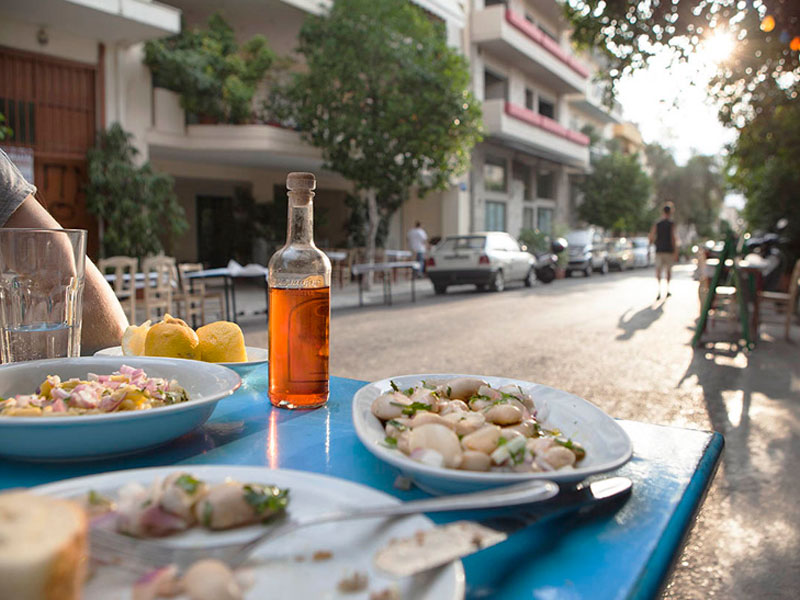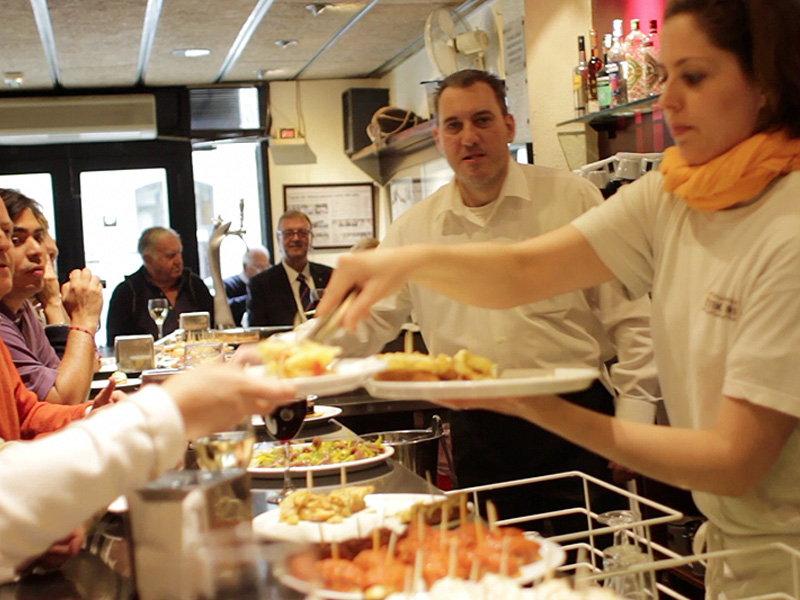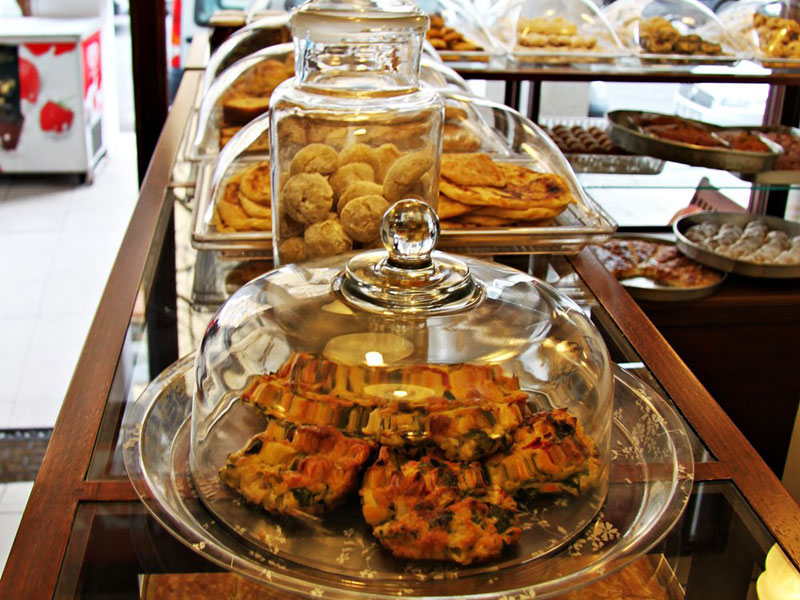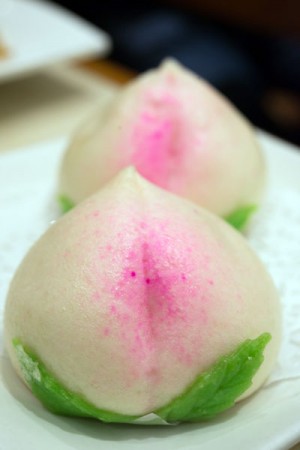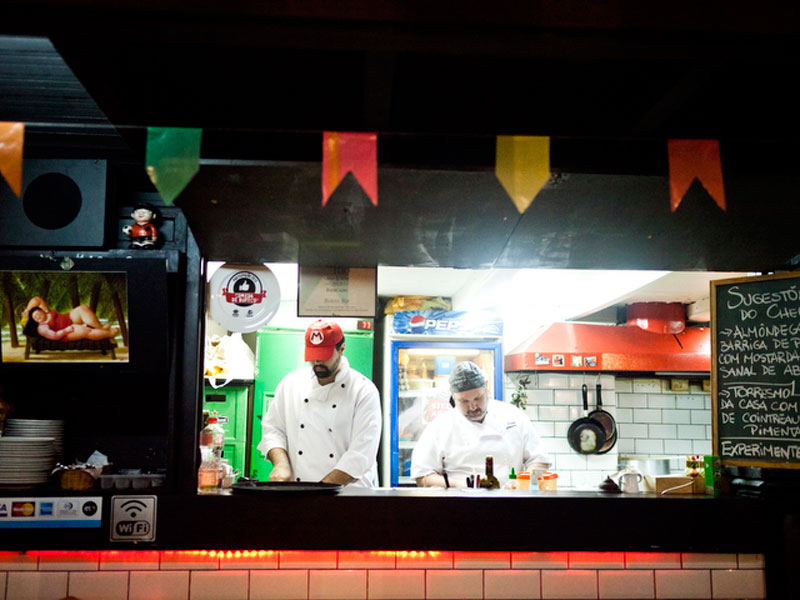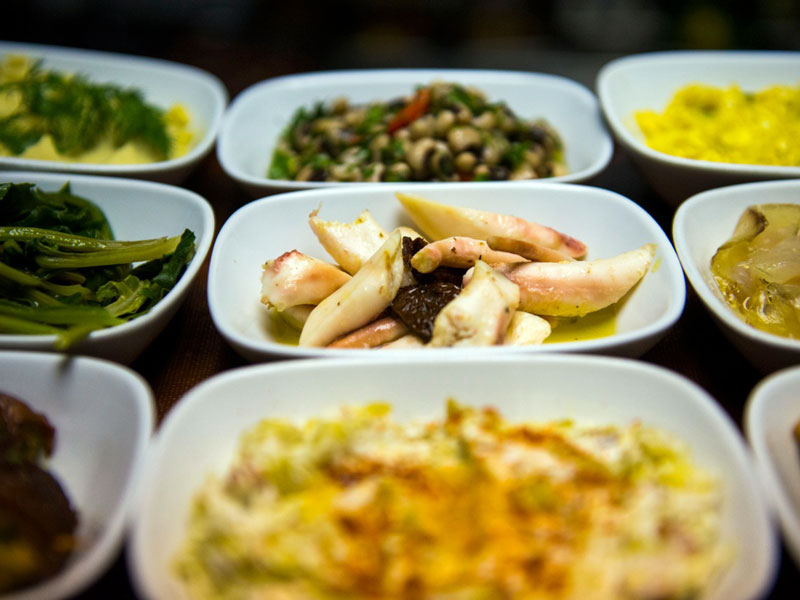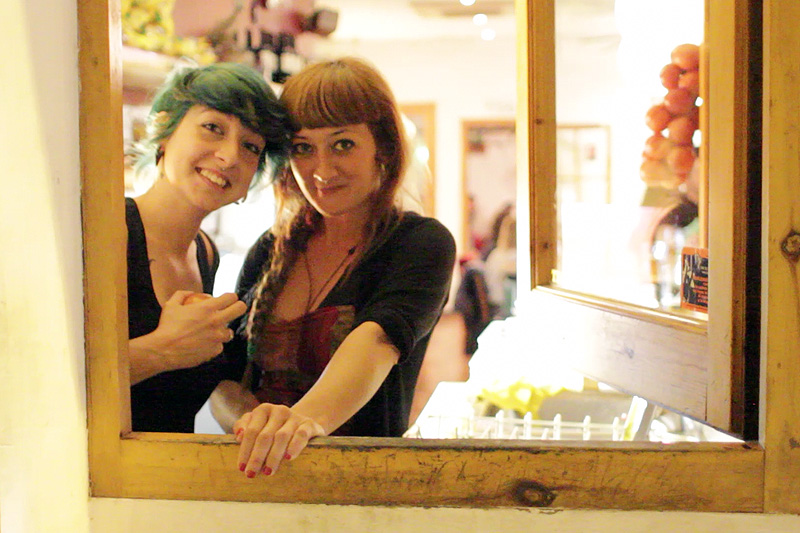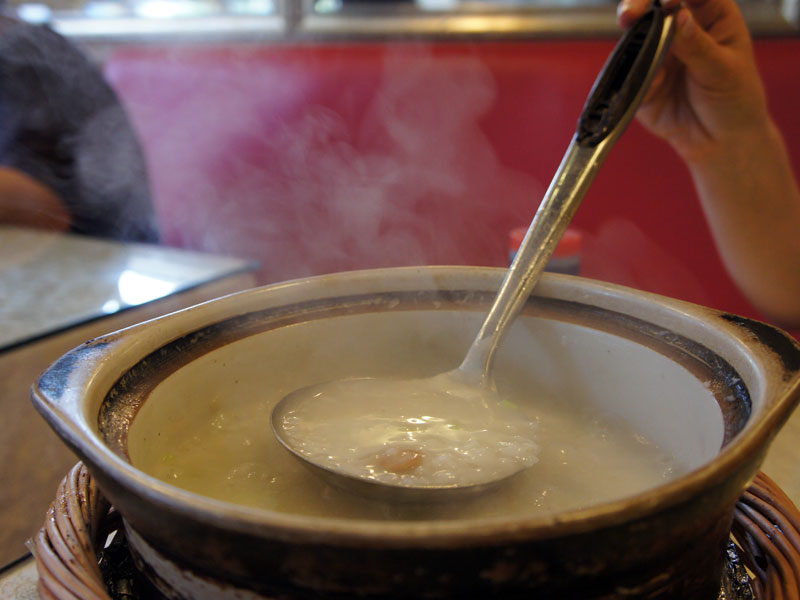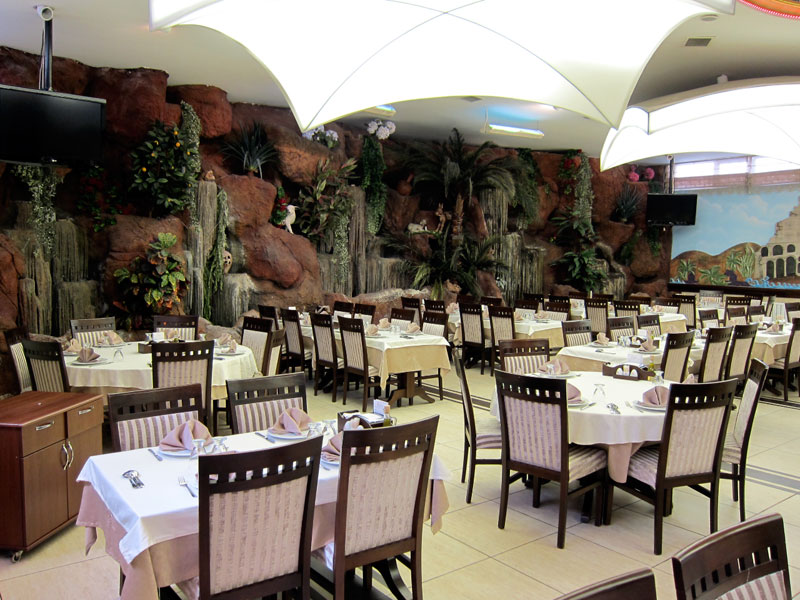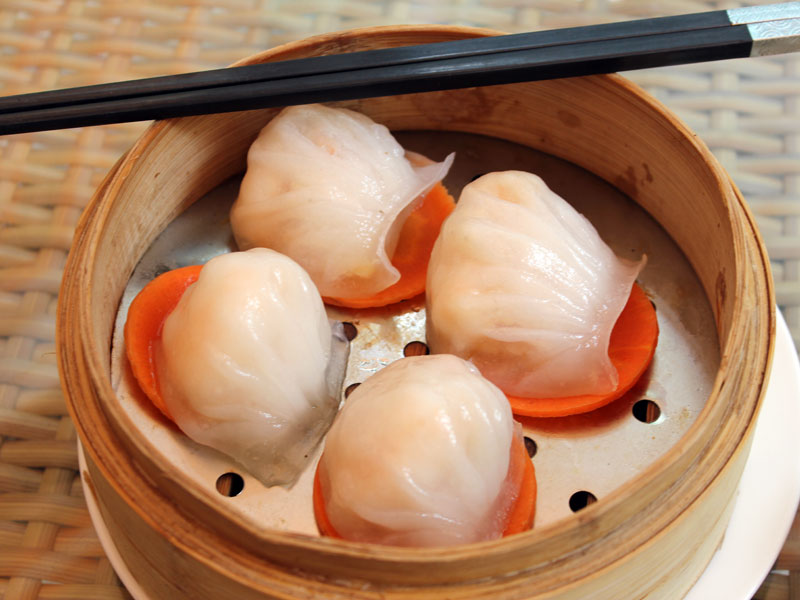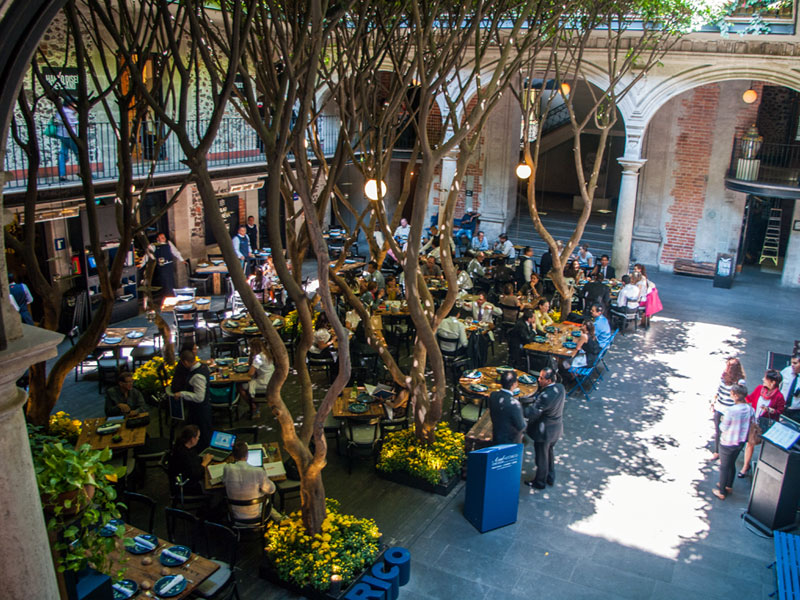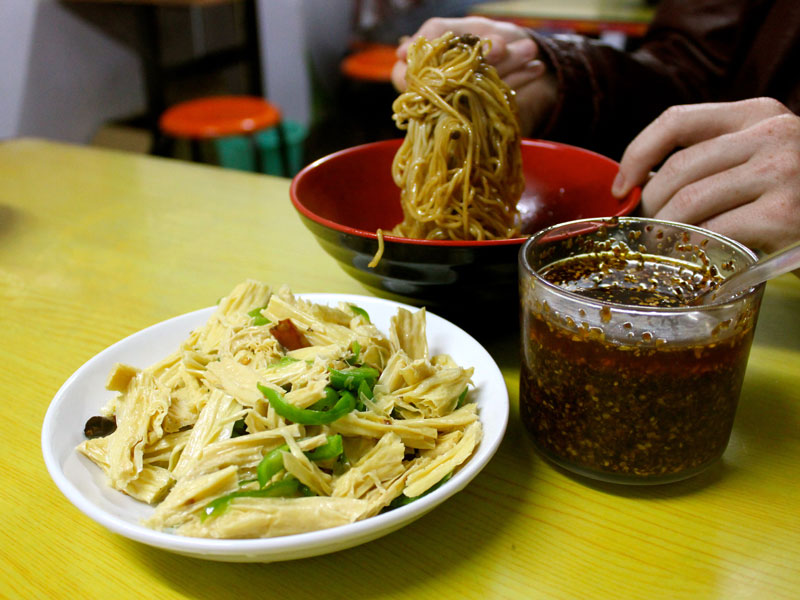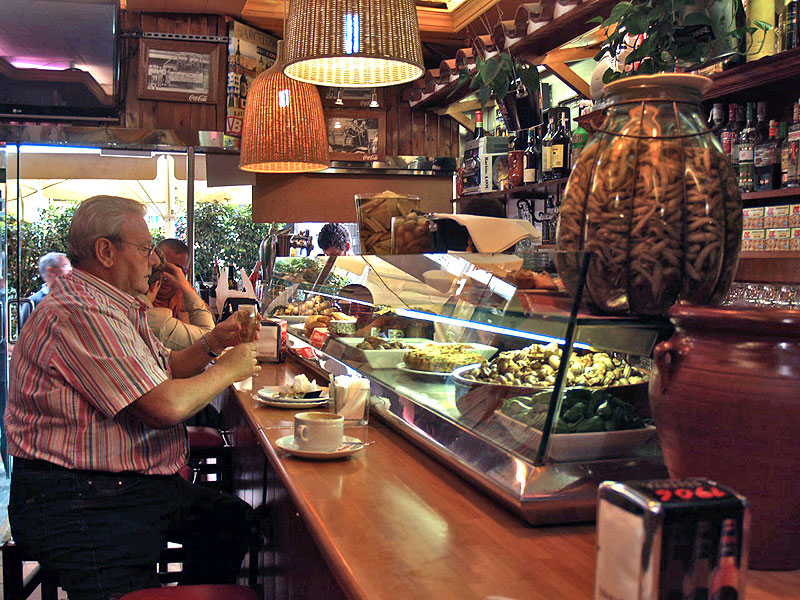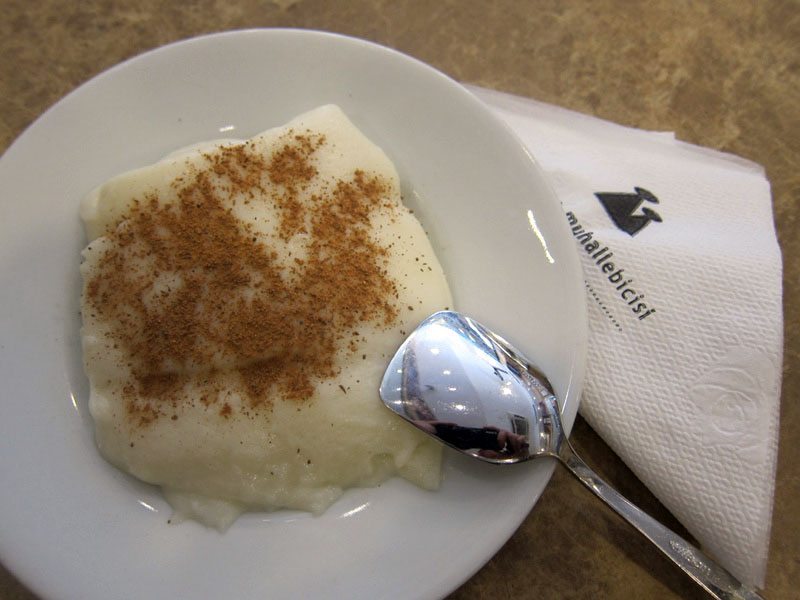We can't find the internet
Attempting to reconnect
Something went wrong!
Hang in there while we get back on track
Search results for
Athens
CB on the Road: Strofi, Piraeus’s Hidden Seafood Gem
It’s a long drive from Athens to Perama, the westernmost terminal of the port town of Piraeus, and the payoff is, at first sight, minimal. To the left is the port’s industrial zone – a forest of blue and orange cranes that tower over the sea. To the right is a stretch of industrial wasteland: old electricity plants, derelict factories, walls with enormous graffiti celebrating Piraeus’s very successful team, Olympiacos, and then a jumble of recently built high-rise buildings on a rocky hill. First populated in the 1920s by immigrants from Asia Minor, Istanbul and the Pontus (Black Sea) region, this suburb of Piraeus now has about 25,000 residents, most of whose livelihoods depend on the dockyards that have been here since the 1930s. Perama remains a proud, working-class neighborhood, and it is no accident that the early Greek hip-hop of the ’90s and the so-called Low Bap hip-hop genre and movement started here.
Read moreIstanbul
Yedikule: An Istanbul Neighborhood’s Bitter Harvest
Foreigners living in Istanbul often say they love the place for its history, while some say it’s the people who make it special. We find life here mystifying for the unpredictable dialogue between the two, the way 15 million or so people reconcile their daily lives with this city’s rich past. To live inside this beautiful crash course is invigorating and, at the same time, a heartbreaking experience. Where else does the elegant silhouette of migratory storks cross a skyline of construction cranes busy laying a metro tube to connect two continents, a project whose progress was stalled by the unexpected discovery of one of the richest underwater archaeological finds ever, a lost port full of ancient boats filled with age-old cargo? Walking these streets, every day we see something so fabulous that it takes our breath away, just as we spot something around the corner threatening to smash it.
Read moreRio
Ask CB: Getting Around Rio's High Prices?
Dear Culinary Backstreets, I hear that prices in Rio are Olympic-sized. How can I eat the best the city has to offer, without spending an arm and a leg? It’s true that prices in Rio aren’t what they used to be. As a recent New York Times article notes, Brazilians pay extremely high prices (particularly relative to wages) for just about everything from food to automobiles, due to both high inflation and a tax system that’s skewed in favor of consumption taxes. The high prices hurt both consumers and businesses. As NPR reported, one Italian restaurant in Sao Paulo recently went as far as taking tomatoes off its menu because the cost had shot up so much. Meanwhile, an influx of money – from the construction boom ahead of the upcoming 2014 World Cup and 2016 Summer Olympics and from the growing oil and gas sector developing off Rio’s coast – is driving up prices even further. Indeed, what’s most surprising about Rio’s priciest locales is how oversized the lines to get into them are.
Read moreWorldwide
Our Culinary Walks in the New York Times!
We are very proud to have been included in a New York Timesarticle about small group culinary tours that appears on the front page of today’s Dining section. Looking at food walks in Istanbul, Paris, Rome and a few other culinary capitals, the article hails the arrival of a new kind of guide – the “food Sherpa”:
Read moreBarcelona
Taktika Berri: Always a Party
When Julián Fernández and Carmen Erdocia moved to Barcelona in 1996, they bought an old fútbol salon in the Eixample that was named Táctica, or “tactics,” in a reference to Spanish football. Julián and Carmen began serving pintxos such as tortilla de bacalao (Spanish omelet with codfish) to hungry futboleros. Eventually, the venue became so popular that they decided to convert Táctica into a Basque restaurant specializing in pintxos. The name was easy: Taktika Berri means “new tactics” in Basque.
Read moreIstanbul
Bizim Ev: The Stash House
Editor’s note: This post was written by “Meliz,” an intrepid explorer of Istanbul’s culinary backstreets and frequent Istanbul guest contributor who would like to keep her anonymity. It all started with Laz böreği. It was not just any Laz böreği that showed up at the dinner party that evening, but perfect Laz böreği: layers of yufka (phyllo), buttery and moist, dusted with confectioner’s sugar, in a symbiotic balance with the custard, which was neither too sweet, nor too eggy, neither too runny, nor too stiff. Juuuust right. Goldilocks would have been proud. And, it turns out, this stuff is addictive.
Read moreAthens
CB on the Road: Exploring the Mythical Port of Piraeus
Piraeus holds the distinction of being Greece’s biggest port, as well as the largest passenger port in Europe. Although it is a mere 20-minute train ride from downtown Athens, most Athenians think of Piraeus with a reverence reserved for a foreign country. There is just something almost mythic about this ancient port, which has been in existence since the 5th century B.C. – the famous opening line of Plato’s Republic is, after all, “I went down to the Piraeus yesterday.” In the modern period, the greater Piraeus area – home to a population of about half a million in Piraeus proper, along with a number of suburbs – has witnessed dizzying highs and lows, especially over the past century. The area has been a major destination for immigrants from elsewhere in Greece, including the islands and the Peloponnese. One of the biggest population expansions came after 1922, when vast numbers of Greek refugees fleeing Asia Minor (modern-day Turkey) migrated to the area and established new working-class neighborhoods, including Nikaia, Keratsini, Drapetsona and Korydallos.
Read moreWorldwide
Culinary Backstreets’ First "Birthday"!
We’re very happy to announce that Culinary Backstreets turns one today! It’s been a wonderful first year and we’re thrilled to see how far we’ve come in this time. When we launched CB last year as the global expansion of IstanbulEats, we set ourselves the goal of covering authentic local eats around the world. As we described in our “Gastro Manifesto,” our mission was to get “off the eaten path,” sharing with readers our explorations of some great cities’ culinary backstreets. From four cities at the beginning – Istanbul, Athens, Barcelona and Shanghai – we grew to a network of six within the year, adding Mexico City and then Rio de Janeiro. Along the way, we’ve covered everything from family-run, hole-in-the-wall restaurants to quirky street foods in each city, from festive holiday culinary traditions to the sometimes fraught intersection of food and politics. A big “thank you” to our always curious and engaged readers, for your interest, support and feedback. Keep reading – and eating!
Read moreBarcelona
Casa Trampa: The Great Escape
Most people who visit Barcelona are sure to spend at least some time at one of the city’s beaches. Yet few are aware that when seeking respite from the bustling urban streets, heading up into the forested hills above the city can be just as pleasant. Vallvidrera, a village at the entrance to Collserola National Park that offers gorgeous views of the surrounding forests and the city below, is just the place for such an excursion. Starting in the early 19th century and up until the 1980s, Vallvidrera served as a vacation destination for wealthy Barcelonans who wanted to escape the summertime heat of the city. The abundance of mansions here, many built in the Modernist style, is a testament to this bygone era. Nowadays, although Vallvidrera is a year-round community that is technically part of Barcelona proper, it’s still a destination for local urbanites and their families wanting to get out of the city and relax, particularly on weekends.
Read moreElsewhere
Diaspora Dining: A Taste of Shanghai in Toronto
Editor’s note: This feature, by guest contributor Gizelle Lau – a Chinese-Canadian food and travel writer based in Toronto – is the first in an occasional series on “diaspora dining,” covering the best places to find our favorite cuisines outside of their places of origin. The history of Chinese in Canada – pioneers who left their native land in pursuit of a better life and future – is a familiar immigrant story.While the first record of Chinese in Canada dates back to the late 1700s, it wasn’t until the late 1800s and early 1900s that they began to arrive in greater numbers, establishing Chinatowns in cities such as Toronto and Vancouver and opening their own restaurants, grocery stores and laundromats. Despite exclusionary government policies that existed for many years, today Canada is home to one of the largest Asian populations outside of Asia, including over half a million Chinese in the Greater Toronto Area alone.
Read moreRio
Botero: Market Force
Editor's Note: Sadly, this spot is now closed. Rio’s Mercado São José looks all but abandoned during the day. The windowless white building with blue trim hosts a small fruit vendor and a thrift shop during work hours. A band practices capoeira – Brazilian martial arts – occasionally on the weekends. But the market bursts with chatter and merrymaking in the evening, thanks in large part to boyish chef Bruno Magalhães and his inventive bar and restaurant, Botero.
Read moreIstanbul
Cibalikapı Balıkçısı: Have Your Meze and Eat It Too
On a night out in Istanbul, we often find ourselves forced to make sacrifices in one or more categories of the overall dining experience. Great food at reasonable prices will surely be laid out in a room decorated in Anatolian kitsch.
Read moreShanghai
Shanghai’s Top 5 Late-Night Dining Spots
The vast country of China has just one time zone, so Shanghai’s East Coast location means darkness comes early and most residents usually eat by nightfall, with restaurants often closing their kitchens around 9 p.m. But for those who keep late hours, nighttime brings out a chorus of pushcart woks and mini grill stands to street corners around the city. Despite often aggressive government crackdowns on these tasty, yet mostly unlicensed, food stands, the migrants who run them are determined to make a living and feed the masses while they’re at it. Our top five list goes beyond these roving vendors to feature a mix of restaurants that stay open late and small family-run gems that cater exclusively to the night-owl crowd.
Read moreBarcelona
Ikastola: Night School
Ikastola means school in Basque. Covering the wall on the right as you walk in is a huge green chalkboard, inviting all to have a hand in the décor. Offering well-priced food and drinks in a cozy, unpretentious atmosphere, this laid-back bar evokes public school right down to the wooden furniture. The venue is owned by three local Basques who met in London and who have known each other since they were knee-high. Guillermo, David and Laura hail from Amurrio, a town in the province of Álava in the Basque Country, roughly halfway between Vitoria and Bilbao. “There weren’t really any bars serving sandwiches,” explains Guillermo. “So we wanted to open a place in Gràcia that would fill that niche.”
Read moreIstanbul
Kalpazankaya Restaurant: Paradise Found
One of the great joys of spring and summertime in Istanbul is the chance to get away for a day to one of the Princes’ Islands, the car-free and forested archipelago that is a short ferry ride away from the city. The only downside to an island hop is actually getting there. As soon as spring makes its first appearance in Istanbul, the hordes descend on the mainland’s ferry terminal, filling the boats to beyond capacity (at least on the weekends). With your neighbor’s picnic basket sticking into your ribs, the boat ride to the islands is usually less of a pleasure cruise and something more resembling those scenes in natural disaster or science fiction films where a frantic population is forced to huddle together after barely escaping their city’s demise.
Read moreShanghai
Wangji Chaozhou Shaguo Zhou: Congee Time, All the Time
It’s two in the morning at Wangji Chaozhou, a rice porridge (粥, zhōu) restaurant in Changning that stays open till 5 a.m. – late even by the standards of restless Dingxi Lu, a bustling, neon-lit thoroughfare close to several college campuses. The waitress on duty is either suspicious by nature, or made more so by her late-night schedule. She regards us impassively, unwilling to let the slightest flicker of amusement disturb her bored demeanor.
Read moreBarcelona
Spanish Conservas: Gourmet Food? It’s in the Can
In Spain, conservas, or foods preserved in cans and jars, are not simply a matter of economic survival or a source of basic nutrition for students, hikers, military recruits and the like. Rather, the tradition of conservas more resembles that of keeping one’s most beautiful jewelry locked safe in a strongbox, to be brought out only on special occasions like Christmas, birthdays or the victory of a favorite football team. There’s nothing better than some delicate canned cockles to lavish on your parents-in-law before a holiday meal!
Read moreRio
Aconchego Carioca: Pretension-Free Zone
The Praça da Bandeira, an area of Rio that until recent years was mostly known for prostitution and cheap inner-city housing, is rapidly changing. Lying in the shadow of the massive Maracanã Stadium – built for the 1950 World Cup and the planned location of the opening ceremony of the 2016 Summer Olympics – it is alive with new construction and pedestrian traffic, which are changing the tired face of this historical but underappreciated neighborhood. And sitting snugly in the midst of this new buzz is Aconchego Carioca, a restaurant and bar with one of the best beer menus in Rio.
Read moreIstanbul
Hatay Has Kral Sofrası: Kebab’s Krib
In our imaginary primetime lineup, a reality show called “Pimp My Kebab Salon” transforms a drab kebab shop into a grill palace suited to the tastes of the latter-day sultans. Surfaces are suddenly gilded in gold, fountains appear and everything is reupholstered under the watchful eye of the boisterous host with tacky taste. If this TV series existed, a much-loved classic episode would take place at Hatay Has Kral Sofrası, a zany kebab restaurant in a part of the Aksaray district filled with lots of other establishments selling food from Southeast Turkey.
Read moreShanghai
Xin Dau Ji: The Great Outdoors
Nothing beats an alfresco summer meal in Shanghai, yet it’s not easy to find a Chinese restaurant that offers outdoor seating. While Chinese people prefer to shelter under umbrellas during the hottest months, Shanghai’s sun-worshipping expats flock to patios and terraces – most of them located in Western-style establishments. So the opening last summer of Cantonese restaurant Xin Dau Ji, with its expansive deck outside, complete with fans for open-air breezes, was a very pleasant surprise. The venue’s outdoor tables sprawl into the former French Concession’s Xiangyang Park, one of Shanghai’s smallest parks, built in the 1930s for French children. Alongside the bubbling fountains, miniature roller coasters and stone tables, more than a hundred varieties of flowers bloom, making it one of most serene spots in the city to enjoy a meal.
Read moreAthens
Diamonds in the Touristy Rough: Plaka Dining Secrets
Editor’s note: This is the second piece in our series featuring the hidden gems in some of Athens’ most touristy neighborhoods. We previously explored Psyri; it is now time to take on the holy grail of Athenian tourism: Plaka. There’s a reason why this area of old Athens, just below the Acropolis, is the city’s most touristy neighborhood: it has a history of more than 6,000 years.
Read moreRio
The Protests in Rio: CB Reports
When Brazilians take to the streets and block traffic, scoff at law enforcement, set off fireworks and relieve themselves in city corners that have already seen a little too much relief, I usually assume it’s Carnaval and happily join in. But the demonstrations that have brought hundreds of thousands to the streets in recent weeks are decidedly un-carnivalesque. They are a deeply serious cry of frustration from Brazilians who, after decades of remaining quiet, are protesting the yawning gap between the success story the nation sells to outsiders and the basic needs of locals that are still far from being met.
Read moreBarcelona
La Pineda: The Sausage Club
It’s almost impossible to pass through Barcelona without setting foot in the Barrio Gótico, a warren of narrow, winding streets and medieval buildings that is the historic center of the old city. It’s also the epicenter of Barcelona’s tourist trade, which means that amongst all the Zara window displays, souvenir shops and tapas joints of questionable quality, it can be difficult to catch a glimpse of what the neighborhood once was. One lucky day, however, as we made our way through this touristic mishmash, we stumbled upon La Pineda, a true gem of old barrio authenticity.
Read moreShanghai
Ding Te Le: The Late-Night Noodle Oasis
For a Chinese city as fast-paced and increasingly cosmopolitan as Shanghai, there are surprisingly few late-night dining options that don’t involve ordering from the roving, streetside pushcarts that hawk grilled skewers or fried rice and noodles. Unfortunately, these midnight vendors are not always where you want them to be when you need them most, after 10 beers. Enter Ding Te Le.
Read moreMexico City
Cactus Popsicle? Touring Mexico City's Ice Cream Scene
In Mexican cuisine, sweets are for the most part simple treats that are enjoyed at the park, market or beach, such as caramelized fruits and vegetables, blocks of nuts or amaranth seeds held together with honey, or small rice paper cakes filled with honey. The common denominator of most of these sweets is their simplicity. When it comes to ice cream and other frozen delights, however, the country truly shines, with an astounding variety of cold treats to please sweet tooths of every persuasion.
Read moreIstanbul
Mall Busters: Istanbul Beyond the Food Court
With the brutally forceful clearing of Gezi Park of its temporary inhabitants by Turkish police, the recent protests in Istanbul have lost the imposing physical presence that, incredibly, lasted for two weeks. These days, protestors are tossing ideas onto social media walls to see what might stick. To keep the resistance alive, we’ve been urged, via Facebook, to take part in all sorts of acts, passive and active, madcap and practical. But the one that really struck a chord with us is a campaign not to spend any money in shopping malls, not to even enter shopping malls, and to spend only what we must at small, local shops. Boycott the mall? Now, that’s a battle we’ve been waging since the late 1980s.
Read moreAthens
Pandeli: An Istanbul Classic Reborn in Exile
Editor’s note: We're sad to report that Pandeli is now closed. This guest review by Nicolas Nicolaides, an Istanbul-born Greek and Ph.D. student in history who moved to Athens as a child, offers a personal look at a famous Istanbul-Greek culinary landmark and its Athens outpost. The Istanbul Greeks (aka Constantinopolitans) have some obsessions when it comes to food, and my grandma was no exception in that regard. Like every Istanbulite transplanted to Athens, she would do her research, taking advice from family and friends in order to find food that would satisfy her high standards – i.e. the way it tasted in Istanbul. For example, Grandma was very fond of meringue cookies and she knew that the best in Athens were to be found at Varsos. She wouldn’t compromise on anything else, so even though Varsos was 12 miles from where we lived, Grandma and I would make an excursion two or three times a year from our largely Constantinopolitan neighborhood of Phaleron to Kifisia (aka Kephisia) to get her precious meringue cookies. I would be rewarded with a couple scoops of ice cream or a creamy rice pudding while Grandma took her coffee on the famous patisserie’s patio.
Read moreShanghai
Ask CB: Shanghai’s Summertime Superfruit?
Dear Culinary Backstreets, I keep hearing buzz about “yangmei” season in Shanghai. What’s all the fuss about this fruit? What’s in a name? Shakespeare could just as easily have written, “A yángméi (杨梅) by any other name would taste as sweet.” This little red Asian fruit has a plethora of monikers: Myrica rubra, Chinese bayberry, yamamomo, Japanese bayberry, red bayberry and waxberry. But a decade ago, the sweet and sour fruit was rebranded as the yumberry in the United States (where it is sold in juice and powder form, but not fresh, due to an import ban on the live fruit) to stand out from other exotic “superfoods.”
Read moreIstanbul
Drinking Culture: Tapping the Ayran (Powder) Keg
Editor’s note: While the fate of the Gezi Park occupation is being hotly discussed, we’ve been spending our time sipping deeper into Turkey’s other great debate: what is the country’s national drink? In the spirit of national reconciliation, here is our report. The recent protests that raged across Turkey may have been sparked by the government’s ham-fisted efforts to bulldoze a precious stand of trees in Istanbul’s Gezi Park, but the country’s eaters and drinkers had already gotten a taste of Ankara’s increasingly meddlesome overreach during the weeks and months before.
Read moreRio
Ask CB: Exploring Rio’s Culinary Scene Safely?
Dear Culinary Backstreets, What is the situation in Rio de Janeiro these days in terms of personal safety? Is it dangerous for foreigners, or can we explore the city beyond the beachside Ipanema hotels? Rio de Janeiro is a city with two very divergent reputations. On the one hand, gringos know the city through ultraviolent films like City of God and seemingly endless news stories on shootouts between drug traffickers and police in the city’s makeshift favelas. On the other hand, it’s a seaside Carnival paradise as carefree as Carmen Miranda, swarming with deep-pocketed offshore oil workers and booming with new hotel and infrastructure construction leading up to the 2014 World Cup and 2016 Summer Olympics. What gives?
Read moreShanghai
Lu Dajie: Big Sister Knows Best
It’s not every day that you find a former national volleyball champ in the kitchen, but that’s just the case with Lu Dajie (aka “Big Sister” Lu) and her eponymous restaurants. After a successful career with the Chinese military’s volleyball team, followed by years working in restaurants for others, she left her hometown of Jianyang in Sichuan province with her brother, bringing her region’s famous cuisine with her. Now, in Shanghai, she is slowly building an empire.
Read moreAthens
Diamonds in the Touristy Rough: Oinopoleion
Editor’s note: This is the first piece in a series in which we explore the hidden gems in some of Athens’ most touristy neighborhoods. The streets of Psyri, Plaka, Gazi and other popular areas are full of restaurant signs trying to lure diners in, but which of them are truly worth your time and money? Culinary Backstreets is on the case.
Read moreMexico City
Azul Histórico: From the Files of the Culinary Detective
There wouldn’t be much of a revived culinary scene in Mexico City without chef Ricardo Muñoz Zurita. A kind of recipe detective and writer of several well-regarded Mexican cookbooks, including the superb Diccionario Enciclopédico de Gastronomía Mexicana, he has been even more successful in his restaurant ventures. After his humble Café Azul y Oro at the National Autonomous University of Mexico (UNAM) received rave reviews, he expanded on its concept – a menu of traditional regional Mexican cuisine based on sometimes forgotten recipes he had gathered through his field research – by opening a larger restaurant in the hip Condesa neighborhood in 2010. Two years later, he opened a third location in a beautifully restored building in the Centro Histórico, which has proven to be his most successful venture yet.
Read moreBarcelona
Ask CB: Local Cafés in Barcelona?
Dear Culinary Backstreets, Where can I go in Barcelona when I'm tired of sightseeing and I just want to sit down and relax with a cup of coffee? Visiting museums and landmarks can be a lot of fun when you're a tourist but sometimes you can learn more about the life of a city by sitting in a chair in a café than you can by reading any guidebook. In Barcelona, there's no shortage of cafés but like anywhere else, it can sometimes be a bit tricky to find one that has just the right ambiance.
Read moreIstanbul
Preserving Istanbul’s Soul, One Bite at a Time
We generally prefer to keep our nose in a bowl of soup and out of the political arena, but over the weekend, Istanbul’s politics seeped through the cracks in our windows, in the form of teargas and general mayhem. As longtime foreign residents of Istanbul, we’ve found it relatively easy to steer clear of political activity, but every so often it barges into our homes and turns our stomachs.
Read moreRio
Raising Cane: Cachaça’s New Day
To call someone a cachaceiro in Brazil is to deal a pretty low Portuguese blow. The word translates roughly to “drunkard” and evokes the image of an unkempt alcoholic clutching a plastic bottle of the powerful local liquor known as cachaça. It’s no coincidence that the name of the drink made with cachaça, the caipirinha, comes from the word caipira, roughly meaning “redneck” or “country.” That the national spirit is invoked in insults is emblematic of the poor image the drink has long had, but which has recently been changing. Like the newly assertive Brazil, the sugarcane-based alcohol is finding its way into chic circles where it was once seen as a bit cheap and rustic. In the past, a posh dinner host in Brazil would offer her guests a uisque (whiskey) or imported wine. But these days, it seems cariocas are finally embracing the truth: the caipirinha is a profoundly refreshing godsend on a steamy Rio summer night. A thriving cachaceiro scene is now budding both in Brazil and among a growing fan base abroad.
Read moreShanghai
Henan Lamian: The Noodle Ties That Bind
You could walk past the shoddy exterior of Henan Lamian every day without giving it a second glance, but the noodle shop hidden within is worth a double take. In our six years of eating there whenever the craving strikes (and it inevitably does, several times a week), this hole in the wall has become our local mainstay, providing cheap and consistently good noodles around the clock.
Read moreAthens
Ideal: The Institution
Editor's note: We regret to report that Ideal has closed. There is just something special about Ideal, one of Athens’ oldest restaurants, which recently celebrated 90 years in business. Perhaps it’s the marble and glass Art Nouveau entrance with gold lettering, which makes the venue look right at home next to some of the city’s architectural gems, such as the 1930s-era, New York-influenced Rex Theater, which now houses the National Theater of Greece. Or maybe it’s the restaurant’s proximity to the imposing yet decrepit Majestic Hotel just across the street and long-suffering Omonia Square nearby. Taken together, all point towards an almost forgotten bourgeois Athenian identity.
Read moreRio
Rio: State of the Stomach
Editor’s note: As of this week, Rio de Janeiro joins Culinary Backstreets as our sixth city. We’re thrilled to have expanded to four continents, and are looking forward to sharing with readers our explorations of this exciting city's dynamic food scene. Like many things in Brazil's beachside, party-hard Carnival city of Rio de Janeiro, gastronomy has a hedonistic edge to it.
Read moreMexico City
Restaurante Nicos: A Family Affair
Restaurante Nicos got its start back in 1957, when María Elena Lugo Zermeño opened a small cafeteria in the middle-class Colonia Clavería neighborhood offering family recipes passed down through the generations. Over the years, the cafeteria evolved into a full-scale – and well-known – restaurant, one that pulls in customers from across the city with its excellent dishes and warm, inviting atmosphere.
Read moreIstanbul
Istanbul's Top Street Foods
Editor’s note: This post wraps up our special series this week featuring our top street food picks in all of the Culinary Backstreets cities. As rapidly as Istanbul marches toward its modern destiny, street food in this city is still served the old-fashioned way, by boisterous ustas with a good pitch and, sometimes, a really good product.
Read moreAthens
Athens’ Top Street Foods
Editor’s note: This is the fourth installment in our street food series this week, featuring dispatches on the best streetside eating in all the cities Culinary Backstreets covers. Before we get down to the business of discussing the best of Athens’ street food, a disclaimer: Athens is at a disadvantage when it comes to streetside eats. For one thing, a lot of venues – souvlaki joints, pizza parlors and even offal soup places – are open all night or even 24/7; they are just not serving on the street, though.
Read moreBarcelona
Barcelona’s Top Street Foods
Editor’s note: This feature from Barcelona is the third installment in our series this week devoted to the top street foods in each of the Culinary Backstreets cities. In Barcelona, a great deal of eating is done in the streets. Sidewalk cafés line the plazas and paseos, often to the point that it’s difficult to tell which tables belong to which establishment.
Read moreMexico City
Mexico City’s Top 5 Street Foods
Editor’s note: This feature from Mexico City is the second installment in our street food series this week, highlighting the best streetside eats in each of the cities Culinary Backstreets covers. 1: Pambazos The pambazo is a Mexican sandwich that’s similar in style to the more familiar torta, but not nearly as ubiquitous. Most commonly found at weekly street markets like Sullivan, pambazos are made with hard, white bread rolls soaked in guajillo chili sauce that softens the crust and gives it a warm, orange-red hue. Once dried, the bread is sliced in half and then filled with a generous portion of diced potatoes, chorizo, lettuce, sour cream and sprinkled queso fresco. The bread is quite fragile, so eating the concoction can be somewhat challenging. From the first bite the pambazo starts to disintegrate, and by the end we’re usually scooping up the heavy mess with our fingers. It’s all worth it, though, as the light hint of chili in the bread and the hearty ingredients inside give the dish the same satisfying and belly-filling pleasure that comes with a good bowl of thick stew.
Read moreShanghai
Shanghai's Top 5 Street Foods
Editor’s note: This week we are celebrating street food, in all its fascinating, delicious and sometimes offbeat forms. Each day, we’ll take a look at the top street foods in a different city that Culinary Backstreets covers. This feature from Shanghai is the first installment. 1: Shengjianbao A Shanghai specialty, shēngjiān mántou (生煎馒头) – or shēngjiān bāo (生煎包), as they’re known everywhere else in China – are juicy pork buns wrapped in bread dough, then arranged in a flat, oil-slicked wok in which the bottoms are deep-fried till they are crispy. Although shengjian mantou can be found on most street corners in the morning, we’re especially fond of the delicious misshapen buns at Da Hu Chun. A Chinese Time-Honored Brand (老字号, lǎozìhào), Da Hu Chun has been splattering grease since the 1930s and, nearly 80 years later, has six restaurants across Shanghai. The venue’s chefs use the rare “clear water” technique, frying the pinched side of the dough face-up to create little Frankenstein buns that might not be as photogenic as the more common “troubled water” variety, but that have a thinner skin that gets extra crisp – and we’ll sacrifice good looks any day if it means better flavor.
Read moreMexico City
Corazón de Maguey: Mezcal Goes Upscale
The sap of the spiky maguey plant has long been used by the indigenous peoples of Mexico to prepare pulque, a milk-colored, viscous drink that has roughly the same alcohol content as beer. When they arrived in Mexico, the Spanish were introduced to pulque. Used to imbibing harder stuff, however, the conquistadors experimented with distilling a mash made out of the maguey plant, in the process inventing the beguiling spirit known as mezcal. Previously a liquor considered the province of the poor and working classes, mezcal has in recent years become one of the trendiest and most popular alcoholic drinks in Mexico, with more than 150 different brands now on the market. (Tequila, made from blue agave – a kind of maguey – and produced within a specific region of Mexico, is the best-known member of the mezcal family.) The rise in mezcal’s popularity has led to a proliferation of mezcalerías, wine bar-like spots that specialize in pouring the drink. In Mexico City in particular, mezcalerías have popped up in nearly every neighborhood, and their numbers keep growing.
Read moreBarcelona
Vermuteria Loú: Mistress of Croquettes
Located on busy Carrer de l’Escorial on the edge of Gràcia, Vermuteria Loú is a tiny, cozy venue that is exactly what we look for in a neighborhood place. The little terrace out front, with just four tables and a bar that opens to the street, encourages patrons to sit and take refreshment while observing the local street life. Inside, the scene might consist of individual drinkers slowly savoring a glass of cava at the bar while a group of men sit at the tables in the back, talking and eating one dish brought out from the kitchen after another.
Read moreIstanbul
Göreme Muhallebicisi: The Milkman Stayeth
In the world of chicken breast pudding (a traditional Turkish dessert made with thickened milk and thin strands of poached poultry), elasticity is the quality that the confection is judged upon above all else. Tucking into a real tavuk göğsü requires full concentration, a good bit of dexterity and the proper tool. A special spoon with a flat chopping nose – much like a spade – was designed just to deal with the situation and, as far as we know, this utensil is found exclusively in Turkish pudding shops. So when we got a tip about a muhallebici where “the tavuk göğsü stretches off the spoon much farther than you could fathom,” we knew we’d be dealing with the genuine article.
Read moreShanghai
Baijiu: China’s Firewater
Drinking báijiǔ (白酒) always brings us back to our first illicit taste of hard alcohol – a shock to the system, going down fiery and leaving a shudder-inducing aftertaste on the tongue. And just as many first-time drinkers are left wondering where exactly the attraction lies, the same thing is true for baijiu – at least, until the aftereffects start to kick in. In fact, even the Chinese believe that one needs to drink 300 shots over time in order to truly understand the appeal of baijiu.
Read more


